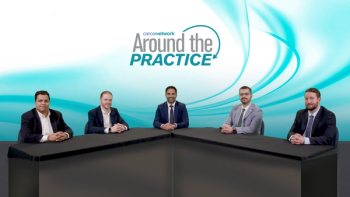DLBCL in Focus: Transforming Outcomes with CAR-T Therapy

EP. 1: DLBCL in Focus: Transforming Outcomes With CAR T Therapy
ByKrish Patel, MD, Saurabh Dahiya, MD, FACP,Nathan Denlinger, DO, MS ,Mohamed M. Hegazi, MD,Samuel Yamshon, MD Panelists discuss how the diffuse large B-cell lymphoma (DLBCL) treatment landscape has seen significant evolution with the integration of targeted therapies and chimeric antigen receptor T-cell treatments, supplementing traditional R-CHOP. However, early relapsed/refractory cases remain challenging due to complex tumor biology and resistance mechanisms. This underscores the need for better up-front risk stratification tools and biomarker-driven treatment selection.

EP. 2: Beyond Salvage: When to Move to CAR T in Relapsed DLBCL
ByKrish Patel, MD, Saurabh Dahiya, MD, FACP,Nathan Denlinger, DO, MS ,Mohamed M. Hegazi, MD,Samuel Yamshon, MD Panelists discuss, when evaluating chimeric antigen receptor T-cell (CAR T) therapy for patients with relapsed/refractory diffuse large B-cell lymphoma (DLBCL), how key considerations include the patient’s fitness, disease burden, prior treatment response, and timing of referral. The limitations of traditional salvage therapy, with historically poor outcomes, must be weighed against CAR T’s potential for durable remissions despite its risks and complexities.

EP. 3: Tailoring Therapy: Patient-Specific Decision-Making in Relapsed DLBCL
ByKrish Patel, MD, Saurabh Dahiya, MD, FACP,Nathan Denlinger, DO, MS ,Mohamed M. Hegazi, MD,Samuel Yamshon, MD Panelists discuss the optimal timing of chimeric antigen receptor T-cell therapy in relapsed/refractory diffuse large B-cell lymphoma (DLBCL), which requires careful evaluation of patient fitness, disease burden, prior treatment response, and logistical factors. Key considerations include performance status, comorbidities, disease aggressiveness, and the availability of bridging therapy. Treatment decisions should be individualized based on patient-specific risk factors, prior therapy outcomes, and care goals while balancing the potential benefits and risks across different lines of treatment.

EP. 4: TRANSFORM and ZUMA-7: A Discussion on Efficacy and Safety of CAR T in R/R DLBCL
ByKrish Patel, MD, Saurabh Dahiya, MD, FACP,Nathan Denlinger, DO, MS ,Mohamed M. Hegazi, MD,Samuel Yamshon, MD Panelists discuss the efficacy and safety of chimeric antigen receptor T-cell (CAR T) therapy in relapsed/refractory diffuse large B-cell lymphoma (R/R DLBCL) and compare the data collected from the TRANSFORM and ZUMA-7 trials, including information regarding the patient control group, patient population prior response, crossovers of both trials, and vein-to-vein time.

EP. 5: CAR T in the Real World: Clinician Perspectives on Outcomes, Toxicity, and Patient Management
ByKrish Patel, MD, Saurabh Dahiya, MD, FACP,Nathan Denlinger, DO, MS ,Mohamed M. Hegazi, MD,Samuel Yamshon, MD Panelists discuss the comparison between clinical trial results and real-world outcomes for chimeric antigen receptor T-cell (CAR T) therapies like liso-cel and axi-cel. Clinical trials have shown promising efficacy and manageable safety profiles for both therapies in treating certain blood cancers. However, real-world evidence continues to emerge through ongoing clinical use and registry data collection.

EP. 6: Rethinking CAR T Timing: Insights on CAR T Efficacy and Patient Selection
ByKrish Patel, MD, Saurabh Dahiya, MD, FACP,Nathan Denlinger, DO, MS ,Mohamed M. Hegazi, MD,Samuel Yamshon, MD Panelists discuss key factors in chimeric antigen receptor T-cell (CAR T) sequencing for relapsed diffuse large B-cell lymphoma, including manufacturing success rates, production turnaround time, and real-world efficacy data. Treatment decisions weigh bridging therapy needs, patient fitness, and center-specific experience with different CAR T products and their reliability.

EP. 7: Personalizing CAR T: Making the Right Call for Each Patient
ByKrish Patel, MD, Saurabh Dahiya, MD, FACP,Nathan Denlinger, DO, MS ,Mohamed M. Hegazi, MD,Samuel Yamshon, MD Panelists discuss how patient-specific characteristics in diffuse large B-cell lymphoma significantly impact chimeric antigen receptor T-cell (CAR T) therapy outcomes, suggesting that standardized treatment algorithms may need refinement. Factors like tumor biology, immune status, and genetic profiles could help optimize therapeutic selection and sequencing.

EP. 8: Auto-SCT or CAR T? A Case-Based Discussion in Relapsed DLBCL
ByKrish Patel, MD, Saurabh Dahiya, MD, FACP,Nathan Denlinger, DO, MS ,Mohamed M. Hegazi, MD,Samuel Yamshon, MD Panelists discuss how the choice between chimeric antigen receptor T-cell (CAR T) therapy and autologous stem cell transplantation (auto-SCT) requires careful evaluation of multiple patient-specific factors. Medical professionals consider disease type and stage, prior treatments, patient age and fitness, cytogenetic risk, donor availability, and timing. CAR T may be preferred for relapsed/refractory cases, whereas transplant remains standard for eligible newly diagnosed patients.

EP. 9: Transplant-Eligible, CAR T Considered: How Do We Decide?
ByKrish Patel, MD, Saurabh Dahiya, MD, FACP,Nathan Denlinger, DO, MS ,Mohamed M. Hegazi, MD,Samuel Yamshon, MD Panelists discuss how, when selecting among chimeric antigen receptor T-cell (CAR T) therapies, medical professionals typically consider several key factors: the specific cancer type and its CD19/BCMA expression, FDA-approved indications for each therapy, the patient’s prior treatments and response history, the therapy’s documented efficacy and safety profile, manufacturing time and availability, and center-specific experience with different products. Patient-specific factors like comorbidities and disease burden also influence the decision.

EP. 10: CAR T in High-Risk DLBCL: Making the Right Choice in Aggressive Disease
ByKrish Patel, MD, Saurabh Dahiya, MD, FACP,Nathan Denlinger, DO, MS ,Mohamed M. Hegazi, MD,Samuel Yamshon, MD Panelists discuss that when selecting a chimeric antigen receptor T-cell (CAR T) product for a patient with an aggressive clinical course and eligibility for cellular therapy, key considerations include urgency, toxicity risks, and efficacy. Factors such as time to manufacture, cytokine release syndrome/immune effector cell–associated neurotoxicity syndrome rates, long-term remission data, and antigen specificity guide decision-making.

EP. 11: The Future of DLBCL: Innovations in Therapy and Patient Care
ByKrish Patel, MD, Saurabh Dahiya, MD, FACP,Nathan Denlinger, DO, MS ,Mohamed M. Hegazi, MD,Samuel Yamshon, MD Panelists discuss how the treatment landscape for diffuse large B-cell lymphoma (DLBCL) is poised for transformation as novel chimeric antigen receptor T-cell approaches integrate with existing therapies, enhancing efficacy and durability. Insights from Tandem 2025 highlight advancements in cellular therapy, including combinatorial strategies and next-generation chimeric antigen receptor T-cell designs, driving optimism for improved patient outcomes.



